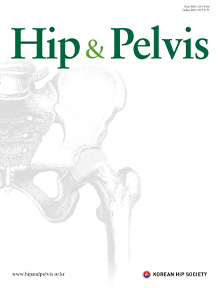Quick links
Related article in
-
Original ArticleSeptember 30, 2017
 0
0
 80
80
 20
20

Surgical Site Infection Following Fixation of Acetabular Fractures
Faizan Iqbal, MBBS, Sajid Younus, MBBS, Asmatullah, MBBS, Osama Bin Zia, MBBS, Naveed Khan, MBBS
Hip Pelvis 2017; 29(3): 176-181AbstractPurpose: Acetabular fractures are mainly caused by high energy trauma. Surgical fixation of these fractures requires extensive surgical exposure which increases the length of operation and blood loss as well. This may increase the risk of surgical site infection. Our aim is to evaluate the prevalence of surgical site infections and the risk factors associated with it so as to minimize its chances.
Materials and Methods: A total of 261 patients who underwent acetabular fracture surgery were retrospectively reviewed. Patients were divided into 2 groups, with or without surgical site infection. Factors examined include patients’ gender, age, body mass index (BMI), time between injury and surgery, operative time, estimated blood loss, number of packed red blood cell transfused, length of total intensive care unit (ICU) stay, fracture type, surgical approach, smoking status, patients’ comorbids and associated injuries.
Results: Fourteen patients (5.4%) developed surgical site infection. Out of 14 infections, 4 were superficial and 10 were deep. The factors that were found to be associated with surgical site infection following acetabular fracture fixation were prolonged operation time, increased BMI, prolonged ICU stay, larger amount of packed red blood cell transfused and associated genitourinary and abdominal trauma.
Conclusion: In our study, we conclude that measures should be undertaken to attenuate the chances of surgical site infection in this major surgery by considering the risk factors significantly associated with it. -
Original ArticleJune 30, 2019
 0
0
 108
108
 23
23

Cup-Cage Construct Using Porous Cup with Burch-Schneider Cage in the Management of Complex Acetabular Fractures
Rajesh Malhotra, MS FRCS, Deepak Gautam, MS
Hip Pelvis 2019; 31(2): 87-94 AbstractPurpose: Cup-cage construct technique was developed to address the massive acetabular defects during revision hip arthroplasty. Indications have extended to complex acetabular fractures with pelvic discontinuity necessitating acute total hip arthroplasty. However, its use is constrained in low socioeconomic countries due to non-availability of the original cages from Trabecular Metal Acetabular Revision System and high cost. We used a novel technique using the less expensive Burch-Schneider (BS) cage and Trabecular Metal Revision Shell (TMRS) to address the problem.
AbstractPurpose: Cup-cage construct technique was developed to address the massive acetabular defects during revision hip arthroplasty. Indications have extended to complex acetabular fractures with pelvic discontinuity necessitating acute total hip arthroplasty. However, its use is constrained in low socioeconomic countries due to non-availability of the original cages from Trabecular Metal Acetabular Revision System and high cost. We used a novel technique using the less expensive Burch-Schneider (BS) cage and Trabecular Metal Revision Shell (TMRS) to address the problem.
Materials and Methods: We reviewed a consecutive series of 8 cases of acetabular fractures reconstructed using a ‘cup-cage construct’ technique using a BS cage along with a TMRS. The mean age of the patients was 61.4 years. Patients were followed up for a mean period of 50.5 months (24 to 72 months). The patients were assessed clinically with Harris Hip Score and radiologically with serial X-rays.
Results: All the patients were available at the latest follow up. The mean Harris Hip Score was 87.2. There was no radiological evidence of failure. One patient had dislocation two months following the surgery, which was treated by closed reduction and hip abduction brace. One patient developed an infection at 3 weeks necessitating debridement. The same patient had sciatic nerve palsy that recovered after 4 months.
Conclusion: This novel technique of the cup-cage construct seems to provide a stable construct at short to midterm follow-up. However, a long-term follow up would be required. -
Original ArticleJune 30, 2023
 0
0
 154
154
 35
35

Primary Arthroplasty for Unstable and Failed Intertrochanteric Fractures: Role of Multi-Planar Trochanteric Wiring Technique
Javahir A. Pachore, MS (Ortho), MCh (Ortho), Vikram Indrajit Shah, MS (Ortho)*, Sachin Upadhyay, MS (Ortho), FIJR†,‡
Hip Pelvis 2023; 35(2): 108-121 , Shrikunj Babulal Patel, DNB (Ortho)§AbstractPurpose: The primary objective of the current study is to demonstrate the trochanteric wiring technique. A secondary objective is to evaluate the clinico-radiological outcomes of use of the wiring technique during primary arthroplasty for treatment of unstable and failed intertrochanteric fractures.
, Shrikunj Babulal Patel, DNB (Ortho)§AbstractPurpose: The primary objective of the current study is to demonstrate the trochanteric wiring technique. A secondary objective is to evaluate the clinico-radiological outcomes of use of the wiring technique during primary arthroplasty for treatment of unstable and failed intertrochanteric fractures.
Materials and Methods: A prospective study including follow-up of 127 patients with unstable and failed intertrochanteric fractures who underwent primary hip arthroplasty using novel multi-planar trochanteric wiring was conducted. The average follow-up period was 17.8±4.7 months. Clinical assessment was performed using the Harris hip score (HHS). Radiographic evaluation was performed for assessment of union of the trochanter and any mechanical failure. P<0.05 was considered statistically significant.
Results: At the latest follow-up, the mean HHS showed significant improvement from 79.9±1.8 (at three months) to 91.6±5.1 (P<0.05). In addition, no significant difference in the HHS was observed between male and female patients (P=0.29) and between fresh and failed intertrochanteric fractures (P=0.08). Union was achieved in all cases of fractured trochanter, except one. Wire breakage was observed in three patients. There were five cases of limb length discrepancy, three cases of lurch, and three cases of wire-related bursitis. There were no cases of dislocation or infection. Radiographs showed stable prosthesis in situ with no evidence of subsidence.
Conclusion: Use of the proposed wiring technique was helpful in restoring the abductor level arm and multi-planar stability, which enabled better rehabilitation and resulted in excellent clinical and radiological outcomes with minimal risk of mechanical failure. -
Case ReportDecember 1, 2006
 0
0
 37
37
 12
12
Traumatic Hip Dislocation in Children: Case Report
Ho Hyun Yun, Gil Yeong Ahn, Il Hyun Nam, Gi Huk Moon, Hyung Gun Kim and Jae Cheol Kim
J Korean Hip Soc 2006; 18(5): 498-502From August 1998 to June 2005, we treated 5 children (7 cases) who suffered with traumatic dislocation of hip. The mean follow-up period was 4.1 years (range: 1~8 years). Acceptable reduction was achieved in all cases by first closed reduction. The complications were 2 redislocations in 2 patients, respectively. Closed reduction is an effective method for treating traumatic dislocation of the hip in children and long term follow-up should be performed for detecting late-onset complications such as avascular necrosis, growth disturbance and traumatic osteoarthritis.
- 1

Vol.36 No.1
Mar 01, 2024, pp. 1~75
Most Keyword
?
What is Most Keyword?
- It is most registrated keyword in articles at this journal during for 2 years.
Most View
-
Pathophysiology and Treatment of Gout Arthritis; including Gout Arthritis of Hip Joint: A Literature Review
Yonghan Cha, MD
Hip Pelvis 2024; 36(1): 1-11 , Jongwon Lee, MD
, Jongwon Lee, MD  , Wonsik Choy, MD
, Wonsik Choy, MD  , Jae Sun Lee, PhD*,†
, Jae Sun Lee, PhD*,†  , Hyun Hee Lee, MD‡
, Hyun Hee Lee, MD‡  , Dong-Sik Chae, MD‡
, Dong-Sik Chae, MD‡ 
-
Treatment of Osteoporosis after Hip Fracture: Survey of the Korean Hip Society
Jung-Wee Park, MD
Hip Pelvis 2024; 36(1): 62-69 , Je-Hyun Yoo, MD*
, Je-Hyun Yoo, MD*  , Young-Kyun Lee, MD
, Young-Kyun Lee, MD  , Jong-Seok Park, MD†
, Jong-Seok Park, MD†  , Ye-Yeon Won, MD‡
, Ye-Yeon Won, MD‡ 
Editorial Office
Laboratory tests performed in hip fracture patients. CTX: carboxy-terminal telopeptide of collagen I, PTH: parathyroid hormone, P1NP: procollagen type I N propeptide, U/A: urinalysis.|@|~(^,^)~|@|First-line treatment option for osteoporosis in hip fracture patients. BP: bisphosphonate, PTH: parathyroid hormone, SERM: selective estrogen receptor modulator.|@|~(^,^)~|@|Osteoporosis medication in patients with rebound phenomenon after cessation of denosumab. Ca+Vit. D: calcium and vitamin D, PTH: parathyroid hormone, SERM: selective estrogen receptor modulator.|@|~(^,^)~|@|The most important recognized factor for atypical femoral fracture.|@|~(^,^)~|@|Preferred osteoporosis medications after cessation of bisphosphonate in patients with atypical femoral fracture. PTH: parathyroid hormone, Ca+Vit. D: calcium and vitamin D, SERM: selective estrogen receptor modulator.|@|~(^,^)~|@|Preferred osteoporosis medications in patients with high-risk of atypical femoral fracture. Ca+Vit. D: calcium and vitamin D, SERM: selective estrogen receptor modulator, PTH: parathyroid hormone.
Hip Pelvis 2024;36:62~69 https://doi.org/10.5371/hp.2024.36.1.62
© H&P
© 2024. The Korean Hip Society. Powered by INFOrang Co., Ltd




 Cite
Cite PDF
PDF



